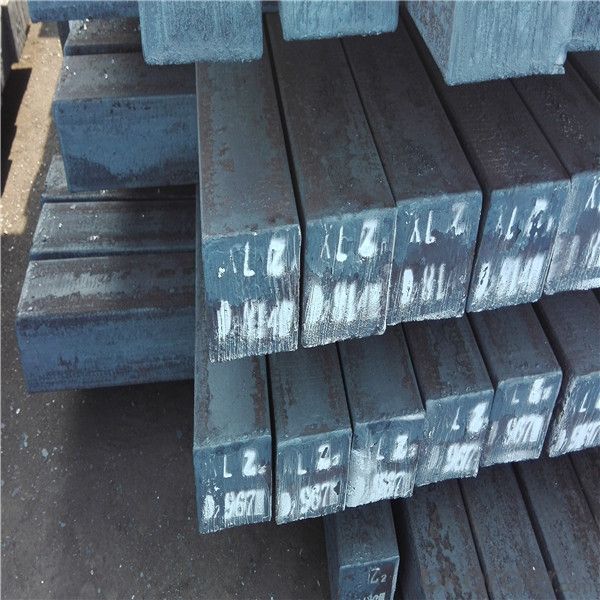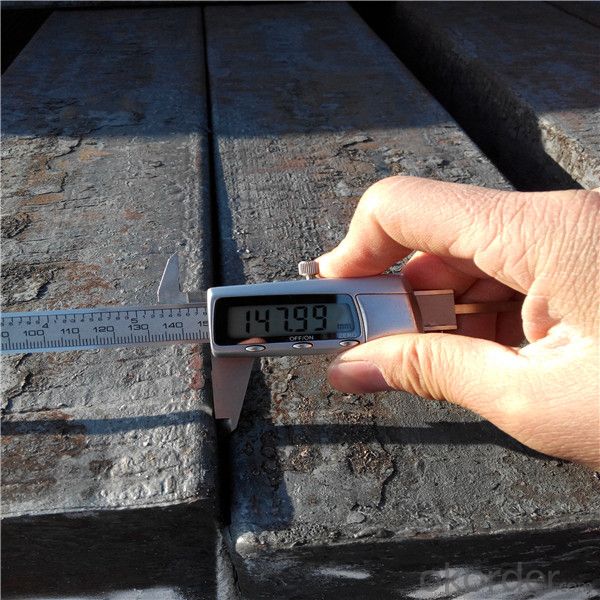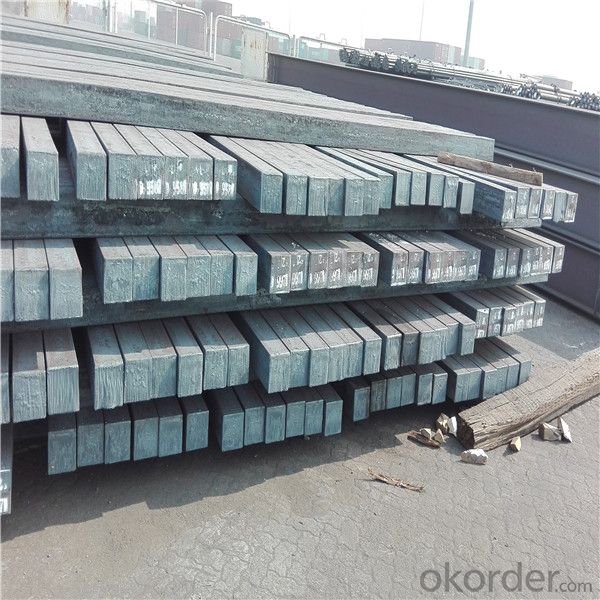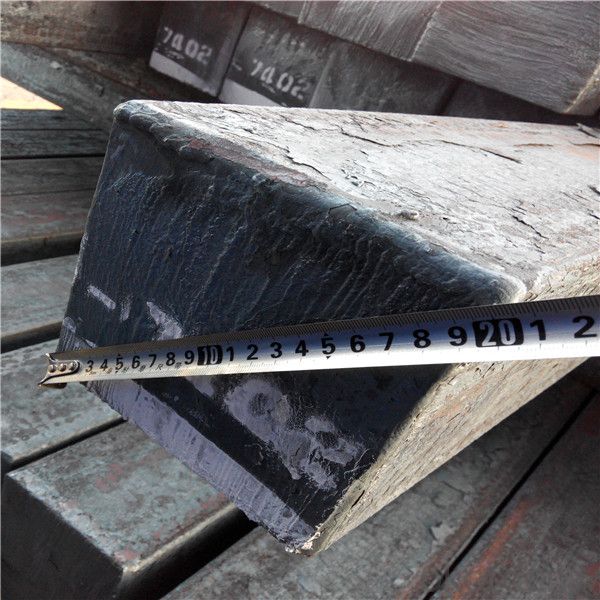Prime Mild Steel Bar Carbon Steel Billets from Manufactures China
- Loading Port:
- Tianjin
- Payment Terms:
- TT OR LC
- Min Order Qty:
- 1000 m.t.
- Supply Capability:
- 16210 m.t./month
OKorder Service Pledge
OKorder Financial Service
You Might Also Like
Item specifice
Billets, or ingots (as they sometimes referred to), are not of practical use until they have been formed
into more functional shapes and sizes. While they have already been put in the furnace, they still require
a series of shaping and molding procedures such as hot and cold working, milling and cutting before they
are sold in hardware stores, or used for different applications. The unformed billets, however, can be used
in striking currency such as coins and as reserves, similar to gold bars.
Gade:
Standard | C(%) | Mn(%) | S(%) | P(%) | Si(%) |
Q195 | ≤0.12 | ≤0.50 | ≤0.040 | ≤0.035 | ≤0.30 |
Q235 | ≤0.20 | ≤1.40 | ≤0.045 | ≤0.045 | ≤0.35 |
Q275 | ≤0.22 | ≤1.50 | ≤0.045 | ≤0.045 | ≤0.35 |
20MnSi | 0.17-0.25 | 1.2-1.6 | ≤ 0.050 | ≤ 0.050 | 0.40-0.80 |
3SP | 0.14-0.22 | 0.40-0.85 | ≤ 0.050 | ≤ 0.040 | 0.05-0.15 |
5SP | 0.28-0.37 | 0.50-1.00 | ≤ 0.050 | ≤ 0.040 | 0.15-0.30 |




Our service :
We have a plant and professional team to provide our best service, from the start of production until the
loading into the vessel, we have a complete quality follow up procedure, to assure our products arrives to the customer with satisfaction. Welcome new and old customers
to contact us for future business relationships! We will give you a surpise price.
Packing :
Within 30 days
1.Standard export package
2.In bundles with steel strips
3.As the requirements of the customers
FAQ:
Q: What is payment terms?
A: FOB 30% T/T IN ADVANCE AS DEPOSIT AND 70% T/T BEFORE SHIPMENT
CIF and CFR 30% T/T IN ADVANCE AS DEPOSIT AND 70% T/T AS THE COPY OF B/L OR L/C AT SIGHT
Q:How to guarantee the quality of the products?
A:We have established the international advanced quality management system,every link from raw material
to final product we have strict quality test;We resolutely put an end to unqualified products flowing into the market.
At the same time, we will provide necessary follow-up service assurance.
Q:How long can we receive the product after purchase?
A :In the purchase of product within three working days, We will arrange the factory delivery as soon as possible.
The pecific time of receiving is related to the state and position of customers.
- Q:What is the role of steel billets in the construction of underground tunnels?
- The construction of underground tunnels heavily relies on steel billets, which are cylindrical steel bars. These bars act as the primary raw material for manufacturing various structural components that are crucial in guaranteeing the stability and safety of the tunnel. One significant use of steel billets is in the production of rebar, also known as reinforcing bar. Rebars are inserted into the concrete walls and floors of the tunnel to provide tensile strength and prevent cracking or collapsing under the immense pressure exerted by the surrounding soil or water. These steel bars reinforce the concrete, making it more durable and resistant to deformation, ultimately enhancing the overall structural integrity of the tunnel. Moreover, steel billets are also utilized to create other essential tunnel components, including tunnel segments and steel arches. Tunnel segments are precast concrete elements that form the lining of the tunnel, often incorporating steel reinforcement for added strength. On the other hand, steel arches are employed in constructing tunnel roofs to offer extra support and stability. Additionally, steel billets are employed in the fabrication of various tunnel reinforcement systems like rock bolts and ground anchors. These systems help secure loose or unstable rock formations, preventing them from collapsing and jeopardizing the stability of the tunnel. Steel billets are also used in manufacturing tunnel supports such as steel ribs and beams, which provide additional strength and rigidity to the tunnel structure. In conclusion, steel billets are critical in the construction of underground tunnels. By being transformed into rebar, tunnel segments, steel arches, and reinforcement systems, they play a vital role in ensuring the structural integrity, stability, and safety of tunnels, ultimately facilitating efficient and secure transportation networks underground.
- Q:What are the different types of rolling processes used for shaping steel billets?
- There are several different types of rolling processes used for shaping steel billets. Some of the commonly used processes include hot rolling, cold rolling, ring rolling, and skew rolling. Each process has its own advantages and is suitable for specific applications. Hot rolling involves heating the steel billet to a high temperature and then passing it through a series of rollers to shape it. Cold rolling, on the other hand, is performed at room temperature and is used to achieve tighter tolerances and improved surface finish. Ring rolling is used to produce seamless rings by gradually shaping the billet using a combination of axial and radial forces. Skew rolling is a specialized process used for producing balls or cylindrical shapes by rotating the billet at an angle to the rolling direction. Overall, these rolling processes offer various techniques to shape steel billets according to specific requirements.
- Q:What are the typical dimensions and weight of steel billets?
- The typical dimensions of steel billets can vary depending on their intended use and production process. However, common dimensions range from 100mm to 200mm in width and height, with lengths typically ranging from 3 to 12 meters. As for weight, steel billets can weigh anywhere from a few hundred kilograms to several metric tons, depending on their size and density.
- Q:How is the surface condition of steel billets checked?
- The surface condition of steel billets is typically checked through visual inspection, where trained personnel examine the surface for any defects such as cracks, pitting, or surface irregularities. Additionally, non-destructive testing methods such as ultrasonic examination may also be used to detect any internal defects that may not be visible to the naked eye.
- Q:What are the quality standards for steel billets?
- Steel billets must meet a set of criteria and specifications known as quality standards to ensure their desired characteristics and properties. These standards are crucial for ensuring the reliability, durability, and safety of the billets throughout their manufacturing and subsequent use in various industries. One primary quality standard for steel billets is their chemical composition. This standard specifies the required levels of different elements, such as carbon, manganese, silicon, sulfur, and phosphorus, present in the billets. The chemical composition directly impacts the strength, hardness, and machinability of the billets. Physical properties of the billets are also essential quality standards. These properties include dimensions, surface finish, and straightness. The dimensions must fall within specified tolerances to ensure compatibility with processes like forging, rolling, or extrusion. The surface finish must be defect-free to maintain the integrity of the billets. Straightness is important for proper alignment and handling during production and fabrication. Mechanical properties are critical quality standards as well. These properties include tensile strength, yield strength, elongation, and impact resistance. The billets must possess sufficient strength and toughness to withstand the forces and stresses they will encounter during manufacturing and in their final applications. Additionally, minimizing or eliminating defects and imperfections is necessary to meet quality standards. Common defects include cracks, inclusions, segregation, and porosity, which can compromise the structural integrity and performance of the billets. Therefore, these defects must be controlled within specified limits. To ensure compliance with quality standards, steel billets undergo various testing and inspection methods. These methods may include chemical analysis, mechanical testing, ultrasonic testing, magnetic particle inspection, and visual examination. By conducting these tests, any deviations from the desired quality standards can be identified, allowing for corrective actions to be taken. Overall, quality standards encompass the chemical composition, physical properties, mechanical properties, absence of defects, and compliance with testing and inspection requirements for steel billets. By adhering to these standards, manufacturers can ensure that the produced billets meet the required specifications and will perform reliably in their intended applications.
- Q:What are the different types of machining processes used for shaping steel billets?
- There are several types of machining processes used for shaping steel billets, including turning, milling, drilling, and grinding. Turning involves rotating the billet against a cutting tool to remove excess material and create a desired shape. Milling uses rotary cutters to remove material from the billet, while drilling creates holes using a rotating cutting tool. Grinding involves using an abrasive wheel to remove material and achieve a smooth surface finish. These processes can be performed individually or in combination to achieve the desired shape and dimensions of the steel billet.
- Q:What is a steel billet?
- A steel billet is a semi-finished product in the form of a rectangular or square shape made from molten steel that has been solidified and cooled. It serves as a raw material for various steel products and is further processed through rolling or forging to be transformed into bars, rods, or other desired shapes.
- Q:What are the main factors affecting the machined surface quality of steel billets?
- The machined surface quality of steel billets is significantly influenced by various main factors. These factors encompass the following: 1. Cutting Speed: The speed at which the tool traverses the billet's surface plays a vital role in determining the surface quality. Higher cutting speeds can generate excessive heat, resulting in thermal damage and subpar quality. Hence, it is crucial to identify the optimal cutting speed to attain a high-quality machined surface. 2. Feed Rate: The rate at which the tool advances into the material during machining is referred to as the feed rate. A high feed rate can cause excessive tool wear, leading to poor surface quality. Conversely, a low feed rate may induce chatter or vibration, causing surface irregularities. Striking the right balance is essential to achieve a smooth and high-quality machined surface. 3. Tool Geometry: The shape, angle, and edge sharpness of the cutting tool significantly impact the surface quality. Tool geometry affects chip formation and the interaction between the tool and the billet. Proper tool geometry can minimize cutting forces, vibration, and improve chip evacuation, resulting in an enhanced surface finish. 4. Cutting Fluid: The choice and application of cutting fluids exert a substantial influence on the surface quality of machined steel billets. Cutting fluids serve multiple purposes, such as cooling the tool and workpiece, lubricating the cutting process, and removing chips. Appropriate selection and application of cutting fluids can reduce friction, heat generation, and tool wear, thereby enhancing surface quality. 5. Billet Material and Hardness: The material composition and hardness of the steel billet also affect the machined surface quality. Different steels exhibit varying levels of machinability, with some being more susceptible to issues like work hardening or built-up edge formation. Harder materials generally necessitate robust cutting tools and specific machining techniques to achieve the desired surface quality. 6. Machine Rigidity and Stability: The rigidity and stability of the machine employed for machining steel billets are crucial factors influencing surface quality. Any deflection or vibration in the machine tool can result in subpar surface finish and dimensional accuracy. Therefore, ensuring proper machine setup, alignment, and maintenance is essential to minimize unwanted vibrations and maximize surface quality. In summary, a combination of the aforementioned factors, along with appropriate cutting parameters and machining techniques, is indispensable for achieving a high-quality machined surface on steel billets. Adjusting these factors based on the billet's specific characteristics and desired surface finish can optimize the machining process and enhance the overall quality of the final product.
- Q:How are steel billets used in the production of gear blanks?
- Steel billets are used in the production of gear blanks as they serve as the raw material for shaping and forming the gears. The steel billets are heated and forged into the desired shape, and then machined to create the gear blanks. These gear blanks are further processed and finished to become fully functional gears, which are then used in various machinery and equipment.
- Q:How are steel billets used in the production of machined parts?
- Steel billets are an essential raw material in the production of machined parts. They are typically used as the starting point for creating various components and products through machining processes such as turning, milling, drilling, and grinding. Firstly, steel billets are heated to a specific temperature to make them more malleable. This process, known as forging, allows the billets to be shaped and manipulated into the desired form. The heated billets are then placed onto a cutting machine, where they are cut into smaller sections called blanks or workpieces. After the billets have been cut, the blanks are further processed using different machining techniques. For example, turning involves rotating the workpiece while removing excess material with cutting tools to create cylindrical shapes like shafts or rods. Milling involves using rotary cutters to remove material from the workpiece, typically to create complex shapes or features. Drilling is another common machining process where holes are created in the billet or workpiece using a drill bit. This is often required to accommodate screws, bolts, or other fasteners in the final product. Grinding, on the other hand, is used to achieve a smooth and precise surface finish on the machined parts. Overall, steel billets play a crucial role in the production of machined parts. They provide a solid and durable foundation that can be shaped and transformed into various components through the application of different machining techniques. Without steel billets, the manufacturing of machined parts would not be possible, as they serve as the starting point for creating the final products that we use in numerous industries.
1. Manufacturer Overview |
|
|---|---|
| Location | |
| Year Established | |
| Annual Output Value | |
| Main Markets | |
| Company Certifications | |
2. Manufacturer Certificates |
|
|---|---|
| a) Certification Name | |
| Range | |
| Reference | |
| Validity Period | |
3. Manufacturer Capability |
|
|---|---|
| a)Trade Capacity | |
| Nearest Port | |
| Export Percentage | |
| No.of Employees in Trade Department | |
| Language Spoken: | |
| b)Factory Information | |
| Factory Size: | |
| No. of Production Lines | |
| Contract Manufacturing | |
| Product Price Range | |
Send your message to us
Prime Mild Steel Bar Carbon Steel Billets from Manufactures China
- Loading Port:
- Tianjin
- Payment Terms:
- TT OR LC
- Min Order Qty:
- 1000 m.t.
- Supply Capability:
- 16210 m.t./month
OKorder Service Pledge
OKorder Financial Service
Similar products
New products
Hot products
Related keywords




























